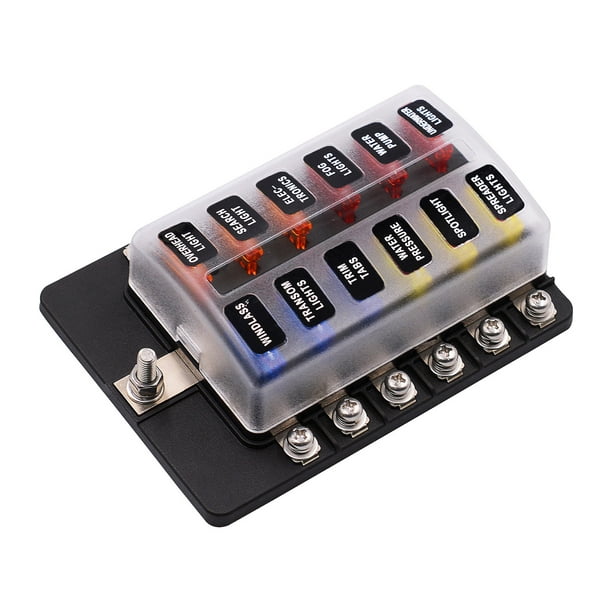Some Known Incorrect Statements About Blue Sea Fuse Block
Wiki Article
Blue Sea Fuse Block Fundamentals Explained
Table of ContentsHow Blue Sea Fuse Block can Save You Time, Stress, and Money.The smart Trick of Blue Sea Fuse Block That Nobody is DiscussingAn Unbiased View of Blue Sea Fuse BlockSome Known Facts About Blue Sea Fuse Block.Blue Sea Fuse Block for DummiesNot known Facts About Blue Sea Fuse Block
Fuses are bolted in position in between the bus bar and also the 2nd collection of electrically isolated bolts. With this setup you can attach the boat's various high-current circuits, such as a windlass, bow thruster, high-output generator, the DC panel, and so on, to the isolated bolts. The various integrates are sized according to the current-carrying capacity of the conductors bolted to them.Some circuits will certainly still need to bypass the isolation button so that they might be left on when the remainder of the boat is shut down. blue sea fuse block. These circuits usually consist of a bilge pump and also any type of charging devices (consisting of photovoltaic panels, perhaps a wind generator, and the inverter if it also increases as a battery charger).
This belongs to the circuit representation we established for the complex instance watercraft in our Boat Electrics course. The tools linked to the fuse block in the upper right are all bypassing the seclusion switch S1. If you register for Watercraft Electrics 101, you will find out exactly how to read such a diagram and also just how to make one for your own watercraft.
The 6-Minute Rule for Blue Sea Fuse Block

With DC circuits, the OCP is always placed in the positive side of DC circuits. Note that some European boatbuilders install fuses and battery switches in the DC adverse side and also on the favorable side, however this is not suggested except in some isolated (drifting) ground DC systems.
This point might go to the battery, the battery switch, the distribution panel, a subsidiary panel, some circulation bus bar, or other connecting factor. If the conductors in the new circuit are no smaller sized than the conductor that feeds the new circuit's point of link, then the OCP for the feeder conductor will sufficiently shield the brand-new circuit - blue sea fuse block.
Getting The Blue Sea Fuse Block To Work
If the new circuit is not properly offered by overcurrent gadgets already in location, added defense is needed at its point of connection, i. e., at its resource of power. Positioning of fuses in the favorable conductor. Keep in mind how a smaller fuse is utilized every time a smaller conductor is attached, Sometimes area restricts how close an OCP gadget can be put to the resource of power.If they must be set up in battery areas, they ought to be ignition protected.) The question then develops, just how close is close sufficient? The common answer, from the ABYC, is within 7" (17. 5cm). The ABYC permits the following, which have been tightened up in the last few years: A conductor linked straight to a battery that is additionally "had throughout its entire range in a sheath or unit such as an avenue, joint box, control box or encased panel" must have its overcurrent protection "as close as practicable to the battery, yet not to go beyond 72 inches (1 - blue sea fuse block.
Gone is the blanket 72" allowance that used to be there. A conductor linked to a resource of power apart from the battery (e. g., the battery switch, the distribution panel, or a few other factor in the DC circuits) that is in a similar way had in a sheath, etc, should have its overcurrent protection "as close as practicable to the point of link to the resource of power, however not to exceed 40 inches (1.
The Single Strategy To Use For Blue Sea Fuse Block
e., anywhere it ties right into the DC system. Considered that generators themselves are a resource of power, it has been open to question whether these added generators needed OCP at the generator itself. This has been fixed in the newest variation of the ABYC E-11 criterion as complies with: "Overcurrent defense is not needed at a generator if the ampacity of the conductor amounts to or higher than the ranked output of the generator."Cranking-motor circuits are not required to have overcurrent security.In the aquatic area, where my site cranking circuits may be long, this method may produce a threat. It makes no sense to have any unguarded circuits on a watercraft.
In winter, the inrush present on a 12V starter motor may be as high as 1,500 amps; the cranking current might be as high as 200 amps. Frequently, cranking conductors are undersized even for the cranking present, allow alone the inrush current. This scenario does not posture a safety problem per se, because these currents are suffered for just a couple of secs, so the conductors do not have time to obtain warm sufficient to create a fire danger.
The smart Trick of Blue Sea Fuse Block That Nobody is Talking About
We made the program with outright newbies in mind. As the electric lots on watercrafts increases, so also does the intricacy of electric circuits and also the capacity for short circuits and also electrical fires.
In the marine field, where cranking circuits might be long, this technique could create a danger. If a car catches fire, the passengers can pull over as well as leap out. If a watercraft captures fire, it is not so simple. It makes try this no sense to have any type of unsafe circuits on a boat.
The smart Trick of Blue Sea Fuse Block That Nobody is Discussing

We made the program with outright newbies in mind. As the electrical lots on boats rises, so too does the intricacy of electric circuits and the capacity for brief circuits and electric fires.
Report this wiki page